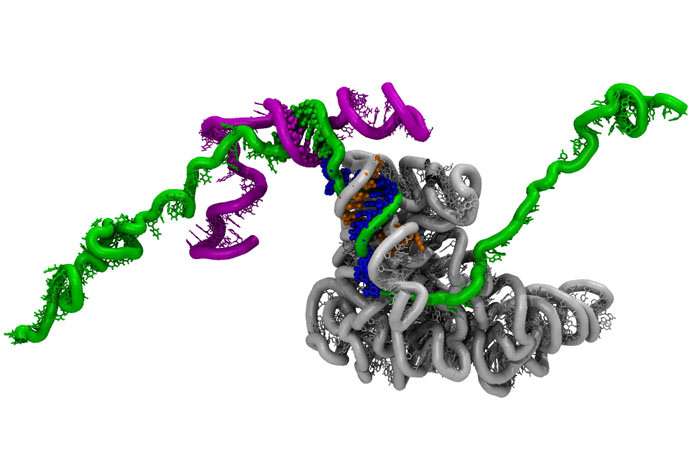Tunable riboregulator switches for post-translational control of gene expression

Recent work by Los Alamos National Laboratory experimental and theoretical biologists describes a new method of controlling gene expression. The key is a tunable switch made from a small non-coding RNA molecule that could have value for medical and even biofuel production purposes.
"Living cells have multiple mechanisms to control and regulate processes—many of which involve regulating the expression of genes," said lead project scientist Clifford Unkefer of the Laboratory's Bioscience division. "Scientists have investigated ways of synthetically altering gene expression for alternative purposes, such as biosynthesis of therapeutics or chemicals. Much of this work has focused on regulating translation of genes. Now we have a way to do this, using a riboregulator."
Synthetic biology researchers have been attempting to engineer bacteria capable of carrying out a range of important medical and industrial functions, from manufacturing pharmaceuticals to detoxifying pollutants and increasing production of biofuels.
"Cells rely on a complex network of gene switches," said coauthor Karissa Sanbonmatsu. "Early efforts in synthetic biology presumed these switches were akin to turning a light bulb on or off. We have produced switches that more closely resemble continuous dimmers, carefully regulating gene expression with exquisite control," she said.
Noted Scott Hennelly, another research team member, "Because these riboregulators can be used to tune gene expression and can be targeted specifically to independently regulate all of the genes encoding a metabolic pathway, they give the synthetic biologist the tools necessary to optimize flux in an engineered metabolic pathway and will find wide application in synthetic biology."
The team's work describes riboregulators that are made up of made up of a cis-repressor (crRNA) and a trans-activator RNAs (taRNA). The crRNA naturally folds to a structure that sequesters the ribosomal binding sequence, preventing translation of the downstream gene; thus blocking expression of the gene.
The taRNA is transcribed independently and the binding and subsequent structural transition between these two regulatory RNA elements dictates whether or not the transcribed mRNA will be translated into the protein product. In this project, the team demonstrated a cis-repressor that completely shut off translation of antibiotic-resistance reporters and the trans-activator that restores translation.
"They demonstrated that the level of translation can be tuned based on subtle changes in the primary sequence regulatory region of the taRNA; thus it is possible to achieve translational control of gene expression over a wide dynamic range," said Hennelly.
Finally they created a modular system that includes a targeting sequence with the capacity to target specific genes independently giving these riboregulators the ability regulate multiple genes independently.
The Los Alamos team, which includes Malathy Krishnamurthy, Scott Hennelly, Taraka Dale, Shawn Starkenburg, Ricardo Marti-Arbona, David Fox, Scott Twary, Karissa Sanbonmatsu and Clifford Unkefer, published the article in the online issue of the journal ACS Synthetic Biology.
More information: "Tunable Riboregulator Switches for Post-transcriptional Control of Gene Expression." ACS Synth. Biol., Article ASAP DOI: 10.1021/acssynbio.5b00041
Journal information: ACS Synthetic Biology
Provided by Los Alamos National Laboratory


















